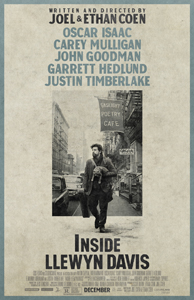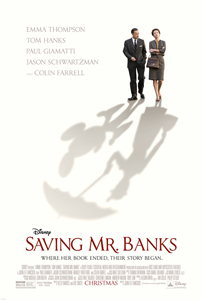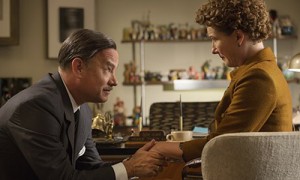Scroll down for our review of “Saving Mr. Banks”
Inside Llewyn Davis
The Coen brothers signature is found both in their characters and in their settings. Both of these things are readily apparent in this film, yet at the same time seem lacking. The title, taken literally, is the story of the film—it’s a portrait of Llweyn’s interior humanity and flawed existence. The problem is that he isn’t an interesting or strong enough character to invest in.
“INSIDE LLEWYN DAVIS follows a week in the life of a young folk singer as he navigates the Greenwich Village folk scene of 1961. Guitar in tow, huddled against the unforgiving New York winter, he is struggling to make it as a musician against seemingly insurmountable obstacles-some of them of his own making. (Synopsis by CBS)”
Habitually unlikable, Llewyn is chaos in the lives he touches. From the beginning, the always metaphorical Coen brothers set Llewyn up for failure. The point is that he gets no where in life. But the Coens don’t excel at writing one-man productions. Llewyn desperately needs something to play off of to make the film more enjoyable. There is no story to tell; he bounces from situation to situation until he inevitably ends up right where he started. Ancillary characters are shifted in and out with what seems to be little more regard than “hey, how about this for a quirky character?” John Goodman is memorable as always, but his purpose is so highly symbolic (as are most the characters and events) that he’ll leave most audiences wondering what they are watching.
If there is one thing the Coens do better than anyone, it is their ability to set a period piece though the camera lens. The color palette is spot on and the imagery is immersive. Add to that the extremely well-done musical score. The inclusion of T. Bone Burnett and Marcus Mumford to score the folk songs is a nice touch–they give you something to look forward to before Llewyn goes back to screwing up his life.
Fans of “Barton Fink” will enjoy this. People who are hoping for “O Brother Where Art Thou?” probably won’t. You can’t argue that the Coens are able to bring their vision to the screen the way few others can. However, that doesn’t always make for an accessible or even enjoyable film for most people. This is a heavy one, so go into it prepared. Would I watch it again? Sure. But in a quiet room with plenty of time to ponder it over.
“See It/ Rent It/ Skip It”: Rent it. You are going to have to watch it a few times to wrap your head around it.
THREE STARS out of four.
Directed by Ethan Coen and Joel Coen
Rated R for language including some sexual references.
Runtime: 1 hr. and 45 mins.
Saving Mr. Banks
There are two things my girlfriend loves most in this world; Disney and Mary Poppins. I’m sure I rank in there somewhere (distant third and possibly fourth behind anything with white chocolate on it). You can imagine how excited she was for this film. That is where the great divide comes down on whether this is a good film: do you accept the Mouse as your personal savior?
Two-time Academy Award (R)-winner Emma Thompson and fellow double Oscar (R)-winner Tom Hanks topline Disney’s “Saving Mr. Banks,” inspired by the extraordinary, untold backstory of how Disney’s classic “Mary Poppins” made it to the screen. When Walt Disney’s daughters begged him to make a movie of their favorite book, P.L. Travers’ “Mary Poppins,” he made them a promise-one that he didn’t realize would take 20 years to keep. In his quest to obtain the rights, Walt comes up against a curmudgeonly, uncompromising writer who has absolutely no intention of letting her beloved magical nanny get mauled by the Hollywood machine. But, as the books stop selling and money grows short, Travers reluctantly agrees to go to Los Angeles to hear Disney’s plans for the adaptation. For those two short weeks in 1961, Walt Disney pulls out all the stops. Armed with imaginative storyboards and chirpy songs from the talented Sherman brothers, Walt launches an all-out onslaught on P.L. Travers, but the prickly author doesn’t budge. He soon begins to watch helplessly as Travers becomes increasingly immovable and the rights begin to move further away from his grasp. It is only when he reaches into his own childhood that Walt discovers the truth about the ghosts that haunt her, and together they set Mary Poppins free to ultimately make one of the most endearing films in cinematic history. Inspired by true events, “Saving Mr. Banks” is the extraordinary, untold story of how Disney’s classic “Mary Poppins” made it to the screen-and the testy relationship that the legendary Walt Disney had with author P.L. Travers that almost derailed it. (Synopsis by Disney)
Winston Churchill put it best: “History is written by the victors.” So it goes with this “inspired by true events” depiction of Walt’s courtship of P.L. Travers’ story. The language of the film is that everything can be saved through the power of Disney. Whether it’s the not-too-subtle imagery or the “magical” ability of the Sherman brothers’ music to soften Travers’ heart, there is an over-the-top nostalgic twinge that never quite feels right. At the same time, Travers’ backstory is flushed out during daydreaming sessions that attempt to draw parallels between the titular character and her own father. How much of that is true is anyone’s guess, but the film sure attempts to make a strong case of it. Let us not forget that Hancock was also responsible for the truth-ish “The Blind Side.” Sure, this script was run through the Disney machine to get it just right, but Hancock has a habit of running loose with the facts for the sake of movie magic. One wonders whether the film would have been better served coming from another studio that wasn’t as concerned with protecting its own mythos.
Granted, that is a very harsh assessment of what is a fairly fun film to watch. If you can put all of that aside and enjoy the teased in songs and lines from “Mary Poppins,” there is a lot to enjoy. The talent is superb and the actors fully embrace their roles. The imagery, while clunky, is enjoyable. The highly-colorized palette is a nice touch. If you can watch this with a child’s eye, you will find it enjoyable. Just like Walt would say, it’s only a movie.
“See It/ Rent It/ Skip It”: See it. Travers was wrong – Dancing Penguins is the jam.
TWO AND A HALF STARS out of four.
Directed by John Lee Hancock
Rated PG-13 for thematic elements including some unsettling images.
Runtime: 2 hrs.









Leave a Reply
You must be logged in to post a comment.